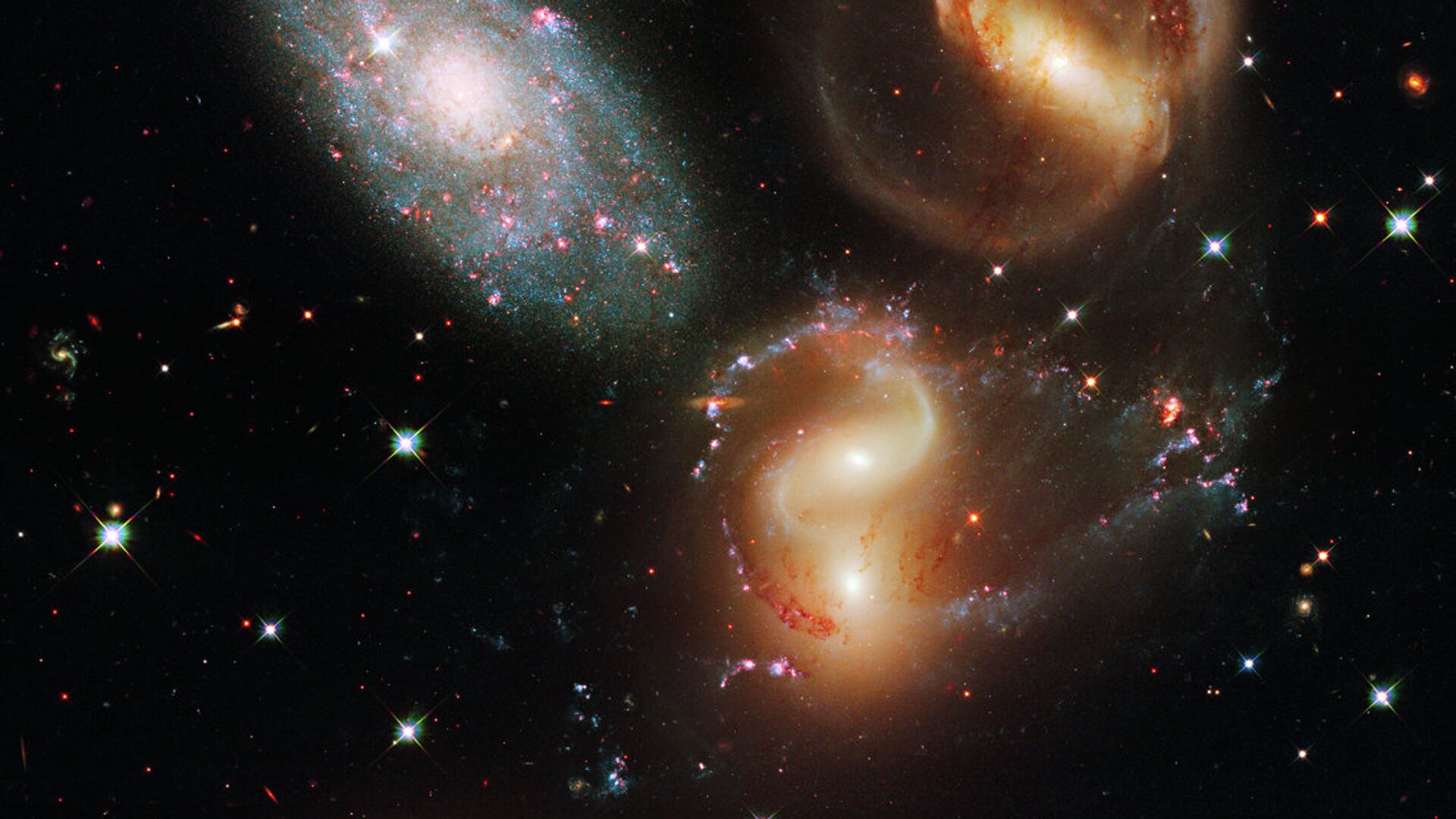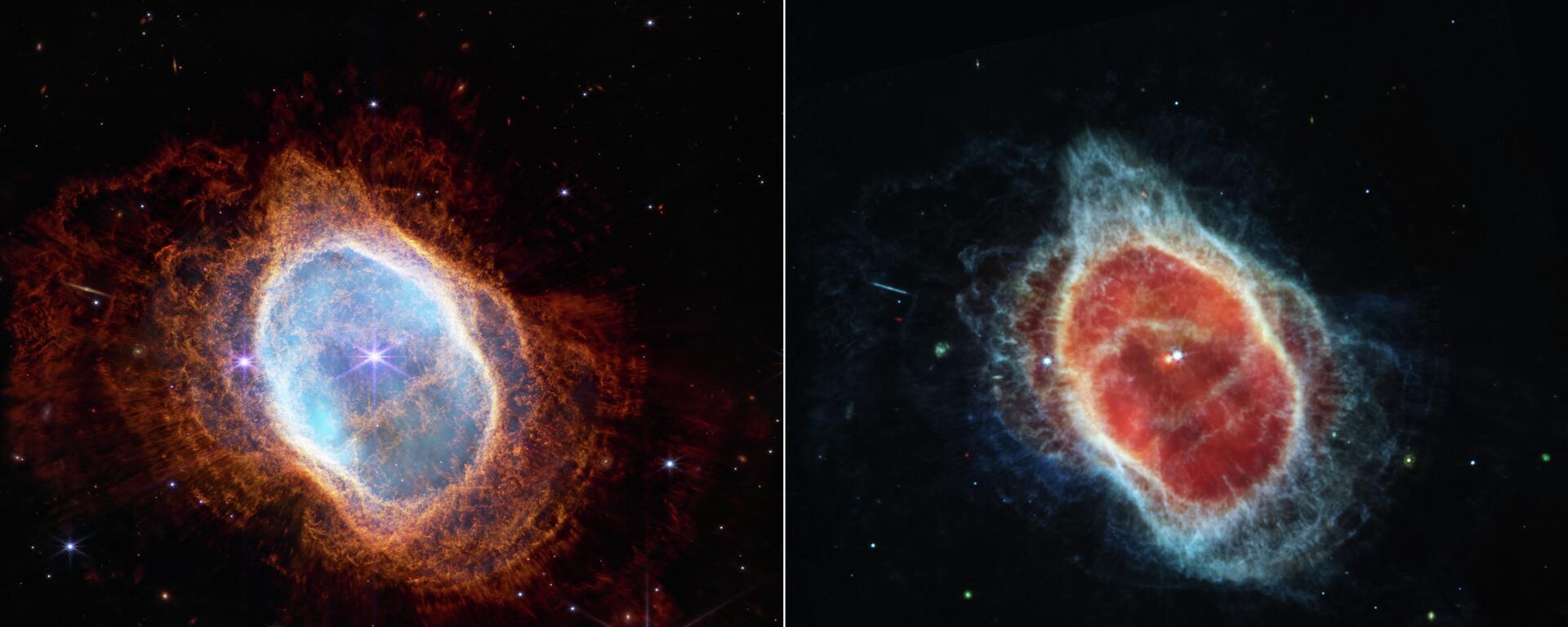https://sputnikglobe.com/20230111/webb-telescope-reveals-clash-of-galaxies-in-detail-1106218136.html
Webb Telescope Reveals Clash of Galaxies in Detail
Webb Telescope Reveals Clash of Galaxies in Detail
Sputnik International
Thanks to modern data and technology, scientists have been able to record processes that remotely resemble those that took place in our own galaxy when it was created.
2023-01-11T10:02+0000
2023-01-11T10:02+0000
2023-01-11T10:02+0000
science & tech
james webb space telescope
atacama large millimeter/submillimeter array (alma)
stars
galaxy
https://cdn1.img.sputnikglobe.com/img/102134/69/1021346950_0:317:1149:963_1920x0_80_0_0_ce52151c8706acdc95f4724978655530.jpg
A team of astrophysicists at the National Radio Astronomy Observatory (NRAO), using the James Webb Space Telescope (JWST) and the Atacama Large Millimeter/submillimeter Array (ALMA), is observing galaxy convergence processes in Stephan's Quintet, located 270 million light years from Earth in the constellation Pegasus. The processes occurring in this group are unique and may help scientists understand the formation of the universe.Stephan's Quintet consists of five galaxies - NGC 7317, NGC 7318a, NGC 7318b, NGC 7319, and NGC 7320. One of them, NGC 7318b, flew into the group of others at a speed of about 800 km/s (for comparison: at this speed it would take only a little over 50 seconds to circle the Earth along the equator). As a result of the collision, a shock wave was formed, which is larger than the entire Milky Way.Due to the fact that this is happening in a zone of a small number of stars, the so-called intergalactic medium, scientists were able to record the course of the process in detail. In the three observation zones, they were able to capture the following: The team has further plans to use the James Webb spectrometers. The heated hydrogen will provide data on the velocities and vectors of its own motion. This will give astronomers details that can provide significant information about the course of galaxy formation.
https://sputnikglobe.com/20220712/nasa-reveals-pics-of-dying-star-cloaked-by-dust--layers-of-light-from-james-webb-space-telescope-1097239075.html
Sputnik International
feedback@sputniknews.com
+74956456601
MIA „Rossiya Segodnya“
2023
News
en_EN
Sputnik International
feedback@sputniknews.com
+74956456601
MIA „Rossiya Segodnya“
Sputnik International
feedback@sputniknews.com
+74956456601
MIA „Rossiya Segodnya“
science & tech, james webb space telescope, atacama large millimeter/submillimeter array (alma), stars, galaxy
science & tech, james webb space telescope, atacama large millimeter/submillimeter array (alma), stars, galaxy
Webb Telescope Reveals Clash of Galaxies in Detail
Thanks to modern data and technology, scientists have been able to record processes that remotely resemble those that took place in our own galaxy when it was created.
A team of astrophysicists at the National Radio Astronomy Observatory (NRAO), using the James Webb Space Telescope (JWST) and the Atacama Large Millimeter/submillimeter Array (ALMA), is
observing galaxy convergence processes in Stephan's Quintet, located 270 million light years from Earth in the constellation Pegasus. The processes occurring in this group are unique and may help scientists understand the formation of the universe.
Stephan's Quintet consists of five galaxies - NGC 7317, NGC 7318a, NGC 7318b, NGC 7319, and NGC 7320. One of them, NGC 7318b, flew into the group of others at a speed of about 800 km/s (for comparison: at this speed it would take only a little over 50 seconds to circle the Earth along the equator). As a result of the collision, a shock wave was formed, which is larger than the entire Milky Way.
"As this intruder crashes into the group… is causing a giant shockwave to form. As the shockwave passes through this clumpy streamer, it is creating a highly turbulent… cooling layer, and it’s in the regions affected… that we’re seeing unexpected structures and the recycling of molecular hydrogen gas. This is important because molecular hydrogen forms the raw material that may ultimately form stars, so understanding its fate will tell us more about the evolution of Stephan’s Quintet and galaxies in general."
Philip Appleton
Astronomer and senior scientist at Caltech’s IPAC, lead investigator on the project
Due to the fact that this is happening in a zone of a small number of stars, the so-called intergalactic medium, scientists were able to record the course of the process in detail. In the three observation zones, they were able to capture the following:
At the center of the shock wave, a cluster of cold molecules disintegrates into a long tail of warmer molecular hydrogen, which then goes through the same process - "
recycling plant."
"What we’re seeing is the disintegration of a giant cloud of cold molecules in super-hot gas, and interestingly, the gas doesn’t survive the shock, it just cycles through warm and cold phases," says Appleton. "We don’t yet fully understand these cycles, but we know the gas is being recycled because the length of the tail is longer than the time it takes for the clouds it is made from to be destroyed."
In another area, two cold clouds are connected by a stream of warm hydrogen. One of these clouds, according to scientists, behaves like a "
high-speed bullet" cutting a strand of gas.
"A molecular cloud piercing through intergalactic gas, and leaving havoc in its wake, may be rare and not yet fully understood."
Bjorn Emonts
Astronomer at NRAO and a co-investigator on the project
In a third area, scientists have discerned protostellar disks and expect the nucleation of a new dwarf galaxy in this area.
"It is likely that pre-existing large clouds of dense gas have become unstable because of the shock, and have collapsed to form new stars as we expect."
Pierre Guillard
Researcher at the Institut d’Astrophysique de Paris and a co-investigator on the project
The team has further plans to use the James Webb spectrometers. The heated hydrogen will provide data on the velocities and vectors of its own motion. This will give astronomers details that can provide significant information about the course of galaxy formation.


